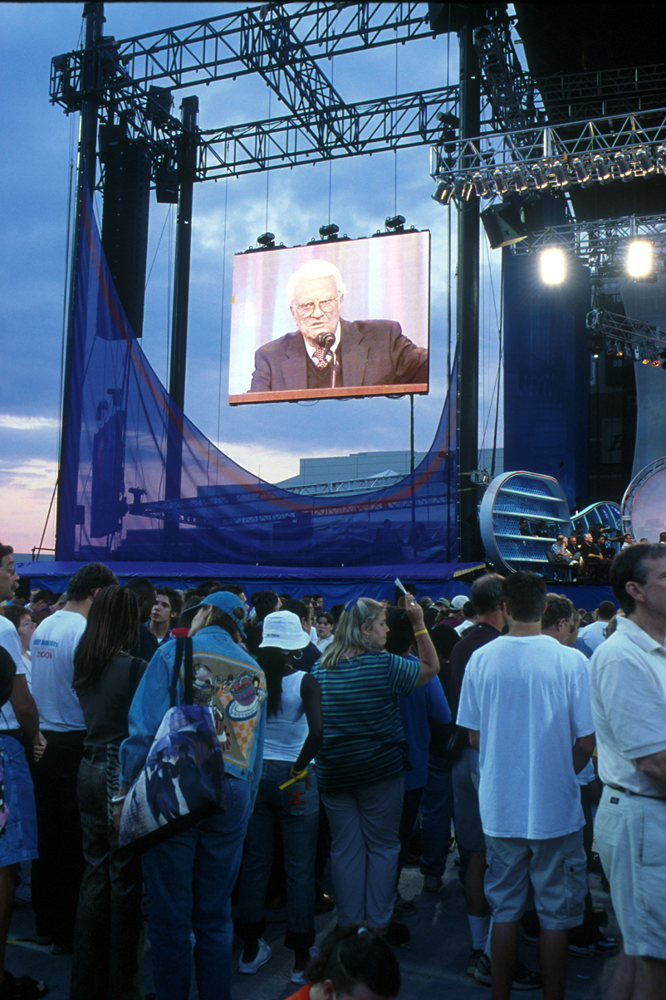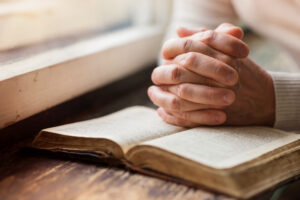
LOUISVILLE, Ky. (BP)–The man stood alone on the football field, tears streaming down his face.
Earlier that day he had driven some 12 hours from Florida to Louisville, Ky., just to hear Billy Graham. It was the first time he had heard the 82-year old evangelist speak. The man listened intently during Graham’s message, then responded during the invitation by walking down the aisle.
Once on the field, the man encountered Kevin Howerton, a crusade counselor and a master of divinity student at Southern Baptist Theological Seminary.
“I saw him standing there with tears on his face,” Howerton said. “… He accepted Jesus as his Lord and Savior.”
Howerton, a native of Huntington, W. Va., said the man had made plans to drive back to Florida the next day.
“He drives a tractor on a farm, and he had always wanted to hear Billy Graham speak,” he said.
Such stories were commonplace during the Greater Louisville Billy Graham Crusade June 21-24 at Papa John’s Cardinal Stadium. More than 180,000 people heard Graham speak during the four days, including an overflow stadium-record crowd of 57,500 on the final night. On that night, 7,500 people sat outside the stadium and watched Graham’s message on a large video screen. An average of nearly 2,300 people responded to the invitation each night.
It was Graham’s first full-scale crusade in Louisville since 1956, giving the Southern Seminary community a rare opportunity to participate first-hand in a Graham crusade. More than 500 members of the Southern community volunteered for various roles.
Each night, students counseled people from nearly every walk of life.
Chris Spradley, a master of divinity student from Nacogdoches, Texas, counseled a 17-year-old teenager who was involved in alcohol and drug use. The teen, invited by friends, said that he and his mom did not have a good relationship.
“He said he’s really been mistreating her — yelling at her and cursing at her,” Spradley said. “He said he just didn’t want to do that anymore. God was working in his heart, and he came forward. … I walked him through the Scriptures. He said he knew without a doubt that Christ died for his sins and that Christ was … the only way he could change.”
Spradley said that a Christian friend from the teen’s school walked onto the field to talk with him.
“She came down to talk to him and encourage him,” Spradley added.
Southern Seminary President R. Albert Mohler Jr., crusade chairman and president, said the crusade served as a unifying force for the Christian community.
“Nothing else has brought together the kind of ethnic and racial and denominational inclusivity as is represented in this crusade; nothing in my experience and nothing in the recent history of Louisville has brought together such a group of committed Christians for one purpose,” he said.
Kim Schmitt a student at Southern Seminary’s undergraduate program, Boyce College, counseled a lady who had attended the 1956 Billy Graham Crusade. The lady said she had made a decision for Christ in that earlier crusade, but had failed to come forward.
“I said, ‘Walking on this grass isn’t going to make you saved,'” Schmitt said. “The more I talked to her, the more she cried.”
Finally, the woman, along with her husband, prayed to receive Christ.
“I said, ‘Are you wanting assurance?’ She said, ‘No, I want to follow Christ.'”
Greg Wafford, a master of divinity student from Vevay, Ind., said the crusade allowed social barriers to be broken down. On one night Wafford led what he described as a rough-looking middle-aged man to Christ.
“He was rough and you could tell he’d had a difficult life,” Wafford said. “The man said he had come to a point in his life that he saw his need. He had recently begun going to church. God allowed me to be there to pick the fruit. It’s amazing. When Christ comes into a person’s life, it brings barriers down. I hugged the man, embraced him, prayed with him and encouraged him and I’m praying for him now.”
The crusade is simply the first step in what many are praying will be a revival. Quoting Winston Churchill, Mohler said the crusade was not the end but simply the “end of the beginning.”
Those who made decisions for Christ were given a Bible study booklet and an audiocassette tape containing devotions. The booklet included the Gospel of John. They also filled out information cards that will be given to local churches. The churches will then contact the new Christians to encourage them in their new walk and to get them involved in church ministry.
“I hope that what begins with this is a revival that sweeps through the churches that were involved, that sweeps through the people that were involved — and the people that have been saved — and keeps radiating out from that,” said Doug Napier, a master of divinity student from London, Ky. “If nothing else, it has had a huge impact on the lives of Christians in local churches getting ready for this crusade and participating in it, as well as the people who have gotten saved who are going to get plugged into a church.”
Spradley agreed.
“I would love to see a revival in Louisville, but first and foremost I want this to motivate the Christians who are already here,” he said. “I want it to motivate them to do evangelism — to share their faith in Christ on a daily basis. I want discipleship of these new Christians. I want to see people in good, Bible-believing churches.”
–30–
(BP) photos posted in the BP Photo Library at http://www.bpnews.net. Photo titles: SHARING STEPS TO PEACE WITH GOD and SHARING THE GOOD NEWS.
















